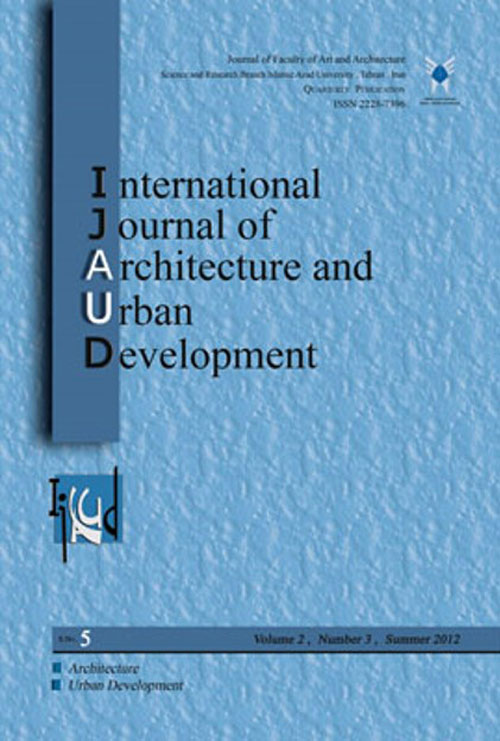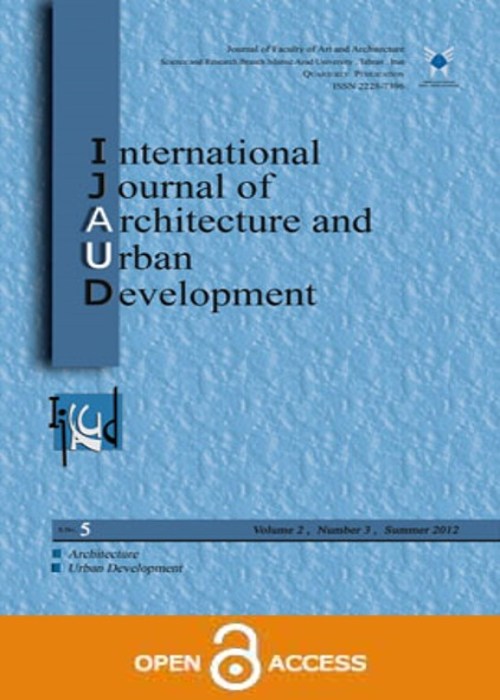فهرست مطالب

International Journal of Architecture and Urban Development
Volume:12 Issue: 3, Summer 2022
- تاریخ انتشار: 1401/04/26
- تعداد عناوین: 6
-
-
Pages 5-14
This paper presents a 'spontaneous location' theory to explain the choice and appropriation of street spaces by street vendors for their private enterprises in the central division of Kampala city. It provides for how street space locations are chosen and acquired for vending activities. To attain an appropriate sample size, the concept of saturation was used, whereby respondents were selected based on the type of goods sold, how goods were sold, the street occupied, time of vending, gender, age, and spatial distribution on the streets. Subsequently, 90 respondents were sampled from 30 streets. The selection of streets was based on the existing land uses the intensity of vending, and their spatial distribution. In the study, direct observations and interviews were used to collect data. Reference was made to location theories and business location decisions. Results indicate that street vendors tend to locate their enterprises on roads and paths with high human traffic that offers a market for their goods. We conclude that the ambiguity of government agencies towards street vendors and the audacity of street vendors as citizens with rights to urban space could promote more random locations of street enterprises and set a stage for further street space use contestation. To avert further conflict arising from the appropriation of spaces, we recommend that streets identified by street vendors for their street enterprises be assessed for feasibility and valorized by city authorities to allow the enterprises to take place and generate revenue for the city.
Keywords: Spontaneous location, Street vendors, Street spaces, Kampala -
Pages 15-30
Cultural planning, as a place-based approach, has been used in some cases, but it is less frequently used in urban parks. In this study, an experimental investigation was conducted to explore how cultural planning can be used to identify the cultural resources of Fateh Garden, as one of the most popular parks in Karaj, and the officials and users' approach to its cultural resources to provide recommendations to improve Fateh Garden conditions. This study was based on direct observations of components, activities, events, interviews with the park users and officials, and a focus group discussion. The results revealed that Fateh Garden acts as a thriving urban park with popular cultural resources. Based on the cultural resources of Fateh Garden and the use of creative methods, this study has provided suggestions for improving its situation. The results presented here may also facilitate improvements in other urban parks based on their cultural resources.
Keywords: Cultural planning, cultural resources, Urban parks, Fateh Garden -
Pages 31-42
The Iranian tribes have their unique architecture due to their lifestyle. They resort to a portable shelter type, the black tent, that can be carried and assembled easily. This article introduces this shelter type applied in the Bakhtiari tribe, which has a history dating back to the Iranian civilization. This structure has retained its identity due to its ability to meet the needs of its inhabitants for centuries and remains a valuable legacy of Iranian architecture. The field study of Bakhtiari tribes is run by assessing their spatial conditions and adapting them to the library studies. The uniqueness of this architecture is in its flexibility and compatibility with the environment. The harmony and rhythm used in interior decoration are directed by climate, culture, customs, and living conditions, thus forming temporary architecture. According to the given site, the natural material type consumed in this structure is feet, creating comfort in the inhabitants' lives. The seasonal and functional condition flexibly dictates the size and plan of the black tent. In this context, to preserve this heritage running in-depth studies on this issue is of the essence.
Keywords: Architectural heritage, Temporary architecture, Local architecture, Bakhtiari tribe, Black tent -
Pages 43-56
The ultimate purpose of the present study is to provide a model for ecotourism development, economic growth, and job creation. The research methodology was descriptive-inferential, and the data collection method was a researcher-made questionnaire. The first part included considering the models of ecotourism development. After inferring and confirming the research hypothesis, the second part presented the economic development model and job creation in the free margin of the northern roads between Emamzadeh Hashem and Rudbar. For proving the research hypothesis, at first, the factors affecting the development of ecotourism were identified and identified, which included eight topics including national identity, job creation, productivity growth, service prosperity, environmental, physical, socio-cultural, and community attitudes and awareness to determine which variable will have the most significant impact on the development of ecotourism. Accordingly, 384 natives and tourists from tourism-recreational and ecotourism complexes in the study area were asked. SPSS software was used for inferential measurement of data, and PLS software was used to present the structural model of the research. The questionnaire and their analysis based on the correlation coefficient and structural model in the first part showed that employment is the most critical factor in tourism development. The analysis results in the first part include the presentation of 32 factors affecting the development of ecotourism. The findings in the second section also present the 11 factors of economic development and economic growth.
Keywords: ecotourism development, Economic growth, job creation, production increase, services prosperity -
Pages 57-72
Ali shah Mosque in Tabriz is one of the remaining buildings from the Ilkhanid period in the region of Azerbaijan in Iran. In historical documents, this building is mentioned with different names such as citadel and mosque. Despite the research done on this building, researchers still have disagreements regarding architectural specifications. In this research, based on archaeological and architectural evidence, the authors seek to answer the following basic questions in the manner of field studies and libraries, which are based on descriptive-historical and analytical-comparative, how are the architectural features of this building represented by the texts of historical documents? How is the porch connected to the tomb? Also, what is the relationship between Ali shah Citadel and the school of the two minarets of the Erzurum in terms of physical and trinity elements? The following hypotheses are raised: according to the results, the pillar behind the altar is originally the tomb of Alisha. The main altar was located inside it and had a green dome with skylights. The way to reach this tomb and the altar were from the stairs leading to the porch. After the huge columns on either side of it, which may have been turned into a minaret, space has become smaller with an indentation. The school and monastery were connected to its western and eastern sides. This general form of composite buildings in a complex is a feature of most buildings of this period. Other results of this study show that the model of the mosque-school of the Erzurum is derived from this building, which shows the cultural connections between the two regions.
Keywords: Ilkhanid period, Tabriz, Ali shah Mosque, School of Khatuniyeh in Erzurum, Mosque - Tomb -
Pages 73-86
The ultimate goal of architectural studios is creative design. To achieve this goal, evaluating creativity in architecture education is considered as one of the important pillars of education. Due to the need for evaluation, the purpose of this study is to construct a test for measuring design creativity based on Torrance's components of creativity in architecture so that it can be used in design education. Therefore, this study seeks to create a measurable criterion for the components of Torrance using the innovative problem-solving method of Triz to evaluate creativity. The present study is descriptive-correlational. The research sample includes 32 architecture students selected by the available sampling method. Test validity is confirmed through confirmatory factor analysis ((χ2 / df = 1.68), (CFI = 0.97), (GFI = 0.98), (AGFI = 0.97) and (0.08 = RMSEA)), which shows that the model fits the data. The correlation between the creativity scale in architecture and Torrance creativity and CREE is significant, indicating the scale's convergent validity. In addition, through the split-half technique and in the method of random pairs, the. coefficient of validity for the component of flexibility, originality, expansion, and the total scale is equal to 0.90, 0.80, 0.75, and 0.91, respectively. Due to the good psychometrics of this tool reported in the research, it is a valid tool that can measure the increase in creativity components in architectural design and can be used in architectural studios and educational and psychological research
Keywords: Scale of creativity, Triz, Torrance, Architecture education


